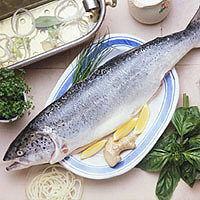health guides
Trout

Varieties
Rainbow trout, native to the United States, are raised in concrete troughs wherever an abundant source of clean water is available. The flesh is mild, delicate, and sweet. Steelhead trout has pink flesh and a mild trout taste. Most rainbow and steelhead available on the market is farm-raised. Arctic char, another trout family fish, either dwells in lakes or lives in salt water, but spawns in fresh water. Whether wild-caught or farm raised, its flesh varies from pink to red, depending on the size. Wild-caught lake trout (also called togue or grey trout) has a higher oil content than other trout and its flesh may be white or pink.
Trout is nearly always sold whole and gutted. Boneless trout is also available.
Copyright © 2024 TraceGains, Inc. All rights reserved.
Learn more about TraceGains, the company.
The information presented in the Food Guide is for informational purposes only and was created by a team of US–registered dietitians and food experts. Consult your doctor, practitioner, and/or pharmacist for any health problem and before using any supplements, making dietary changes, or before making any changes in prescribed medications. Information expires December 2024.


 We are proud to announce that
We are proud to announce that  As the market evolves, customers increasingly request a wider variety of omega-3 options for their lipid...
As the market evolves, customers increasingly request a wider variety of omega-3 options for their lipid...  Maintaining healthy glucose levels is crucial for preventing metabolic conditions like diabetes,...
Maintaining healthy glucose levels is crucial for preventing metabolic conditions like diabetes,...  Looking at formulating a new vitamin blend? Discover
Looking at formulating a new vitamin blend? Discover 







































